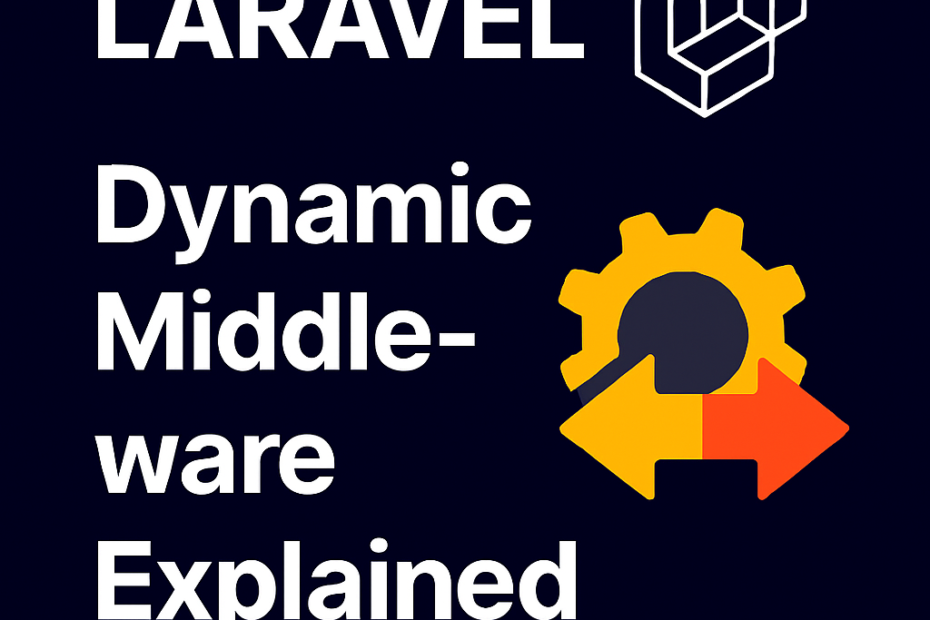Laravel’s middleware system has always been a cornerstone of request lifecycle management. From authentication and throttling to custom logic injection, middleware lets you intercept and shape HTTP requests with precision.
But until Laravel 12.30, middleware was mostly static — defined in Kernel.php, assigned to routes, and executed in a fixed order.
Now, with dynamic middleware, Laravel gives you runtime control. You can attach middleware conditionally, based on user roles, request context, feature flags, or even tenant-specific logic.
Let’s dive into what this means, how it works, and why it’s a game-changer for modern Laravel apps.
🧠 What Is Dynamic Middleware?
Dynamic middleware allows you to attach middleware to a request during runtime, rather than predefining it in route groups or the HTTP kernel.
This means you can:
- Apply middleware based on request data
- Inject logic only when needed
- Avoid bloating route definitions with edge-case middleware
- Build more modular, context-aware applications
🧪 Traditional vs Dynamic Middleware
🔒 Traditional Middleware
Route::middleware(['auth', 'admin'])->group(function () {
Route::get('/dashboard', fn () => view('admin.dashboard'));
});This works well — but it’s static. Every request to /dashboard will run both auth and admin, regardless of context.
⚡ Dynamic Middleware (Laravel 12.30)
use Illuminate\Support\Facades\Route;
use App\Http\Middleware\AdminCheck;
Route::middleware(function ($request, $next) {
if ($request->user()?->isAdmin()) {
$request->middleware(AdminCheck::class);
}
return $next($request);
})->group(function () {
Route::get('/dashboard', fn () => view('admin.dashboard'));
});Here, AdminCheck is only applied if the user is an admin. No need to statically bind it in Kernel.php. This keeps your middleware stack lean and responsive.
🔧 How It Works Under the Hood
Laravel 12.30 introduces the middleware() method on the request object. This method queues middleware to be executed during the current request lifecycle.
Internally, Laravel merges these dynamically attached middleware with the existing stack, preserving order and ensuring proper execution.
You can attach:
- Class-based middleware (
AdminCheck::class) - Closure-based middleware
- Middleware aliases (if registered)
🧩 Real-World Use Cases
Let’s explore where dynamic middleware shines:
1. 🛡️ Role-Based Access
Apply middleware only for specific roles:
if ($request->user()?->hasRole('moderator')) {
$request->middleware(ModeratorThrottle::class);
}2. 🧪 Feature Flags
Enable middleware only when a feature is active:
if (Feature::enabled('new_checkout')) {
$request->middleware(NewCheckoutLogger::class);
}3. 🏢 Multi-Tenant Apps
Inject tenant-specific middleware:
$request->middleware(TenantContext::class);
$request->middleware(TenantRateLimiter::class);4. 🔀 A/B Testing
Route users through different flows:
if ($request->cookie('ab_group') === 'B') {
$request->middleware(ExperimentalFlow::class);
}5. 🔐 API Versioning
Apply version-specific logic:
if ($request->header('X-API-Version') === 'v2') {
$request->middleware(ApiV2Sanitizer::class);
}🛠️ Best Practices
Dynamic middleware is powerful — but with great power comes great responsibility. Here’s how to use it wisely:
✅ Keep Core Middleware Static
Auth, CSRF, and validation should remain predictable and consistent.
✅ Avoid Overuse
Don’t dynamically attach middleware just because you can. Use it for edge cases, not everything.
✅ Document Clearly
Make sure your team knows which middleware are dynamic and why. Consider tagging or commenting them.
✅ Test Thoroughly
Dynamic logic can be harder to trace. Write integration tests to ensure middleware behaves as expected.
🧭 Final Thoughts
Laravel 12.30’s dynamic middleware feature is a subtle but powerful upgrade. It gives you runtime control over request handling, enabling smarter, more modular apps.
Whether you’re building multi-tenant platforms, experimenting with feature flags, or optimizing performance — dynamic middleware lets you shape the request lifecycle with precision.
Middleware just got smarter. Use it wisely.
